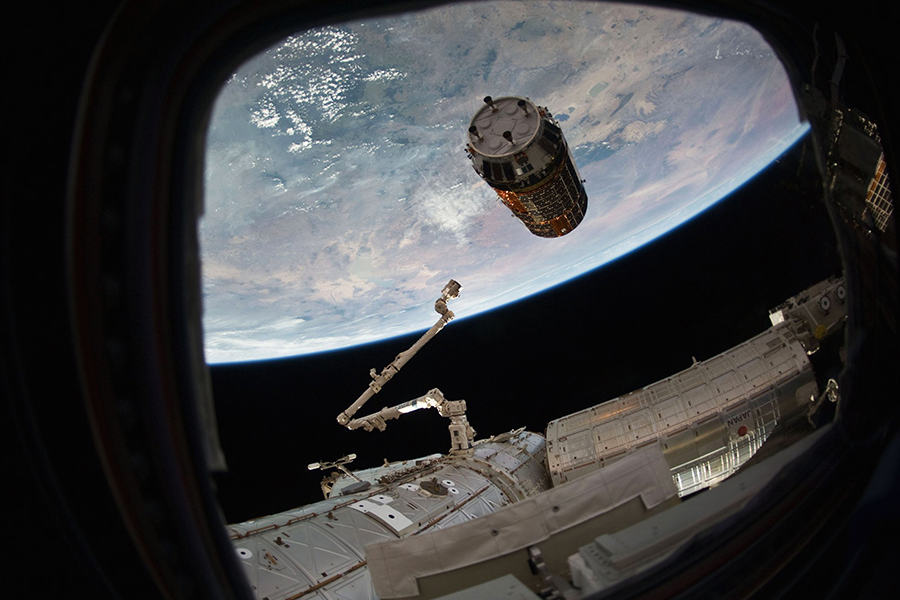With new airlock, International Space Station widens door for commerce
Loading...
For Jeff Manber, a new era in spaceflight won’t be signaled with a high-decibel rocket launch, but by the silent opening of airlock doors.
Mr. Manber serves as chief executive officer of NanoRacks, which on Monday announced plans to install a $15 million commercial airlock model on the International Space Station (ISS) in 2019.
The Texas-based aerospace company has already deployed almost 150 small satellites, known as “CubeSats,” from the airlock of the station’s Kibo module. By working with Boeing Co. to build the new airlock, it aims to triple its deployment capability.
This addition will expand private firms’ presence in low-Earth orbit, which NASA hopes will allow it to focus on exploring the solar system. But the CubeSats have already encouraged the shift to commercial spaceflight.
“Up until recently, we had what I always called a Socialist-designed space program,” Mr. Manber tells The Christian Science Monitor in a phone interview. “We had a group of people sitting in a room, telling you what the purpose of the hardware was for, and they would help design it. Now we have a much more commercial [program].”
“It is fair to say,” he adds, “that the [International Space Station’s] first commercial success has been meeting the needs of governments and companies and universities to deploy satellites.”
CubeSats were first developed in 1999, a year after the first ISS modules were launched. Since then, 510 of these satellites have taken flight. Today’s satellites aren’t just smaller, but cheaper. According to the Motley Fool, prices for CubeSats and other small satellites have dropped from $3 million to as little as $25,000.
Now, the race is on to reduce the cost of getting into orbit. A rocket currently in development by Vector Space Systems will carry a payload into orbit for $1.5 million to $2.5 million. But NanoRacks will see your 10- x 10- x 10-centimeter CubeSat off from the ISS for just $85,000, the company’s marketing and communications manager, Abby Dickes, tells the Monitor in an email.
Few saw the rise of this market. “For years and years,” Mr. Manber remembers, “we all thought, in the space community, that the first big commercial use of an orbiting space station would be breakthroughs in life-saving drugs.... However, in the mysterious way that the commercial marketplace works, the first big commercial hit, the first big legitimate demand for an orbiting space station has turned out to be deploying satellites.”
Manber emphasized that NanoRacks also does considerable business for biopharma companies who use the company’s products to run zero-gravity experiments within the ISS. Robyn Gatens, deputy director of NASA’s International Space Station division, tells the Monitor that “there is great interest in both” internal experiments and satellite deployments.
But the development of small, inexpensive satellites could prove more significant for commercial spaceflight, because it’s spurring private companies to develop hardware that can be used on future spacecraft.
“When the station was built,” Manber says, “the Japanese put up a small satellite deployer that could deploy a couple of satellites every so often. We saw that, and we recognized there's a market need to have a bigger deployer to take care of organizations and companies.”
The first NanoRacks customer’s satellite deployed from Japan’s Kibo module in 2012. As the company builds a dedicated airlock for this purpose, Manber is already thinking about its longer-term significance.
“That airlock can be taken off and put on a [different] platform,” he says. “I see a future very soon, within the decade, where we have a couple of space stations” in orbit.
This vision lines up with one laid out by NASA associate administrator William Gerstenmaier in 2015, in which the ISS, following its expected retirement in the late 2020s, will be replaced by several “single-purpose, small and entrepreneurial” stations.
Private rocket operators like SpaceX will also be a part of this future, as may technology used in the public-private Bigelow Expandable Activity Module added to the ISS last year. But the new airlock, built entirely with private funds, marks a major step toward a privatized orbital sector.
But even if NanoRacks helped usher in this new era, it may need to adapt its business model.
It’s not clear whether one of its key operations – deploying “constellations” of small satellites for Earth-imaging or testing the components of larger satellites – will always provide a reliable source of income.
Manber says that Earth-imaging companies “like the low orbit” provided by the ISS. But Jonathan McDowell, an astrophysicist at the Harvard-Smithsonian Center for Astrophysics, points out that one of these firms, Planet, recently shifted from space-station deployment to regular rockets, which can bring satellites into higher orbits than the ISS’s 400 kilometers, about 249 miles.
Some firms, he explains, would prefer to place their operational satellites at 500 to 600 kilometers, where they’ll last longer before re-entering the atmosphere.
“They'll still use the space station for when they want to test something out,” Dr. McDowell tells the Monitor,” but the bulk of their business is going away from the space station. And I wonder if that's going to be true for a lot of other companies in the long run, that the space station orbit is just going to be too low for the operational constellations, where the bulk of the business is going to be in five years.”
But on the whole, he sees the new airlock as a logical next step for aerospace firms. “All we need to do is get this thing up in the trunk of a Dragon, slap it on the spare port, and then getting the cargos up there, the satellites up there, is a proven path. So I think it's a pretty clear business case for them.”
Manber, not surprisingly, agrees. "Every signal is that we're entering a new chapter of extraordinarily robust commercial [activity] in space, and this is what this airlock is all about.”








